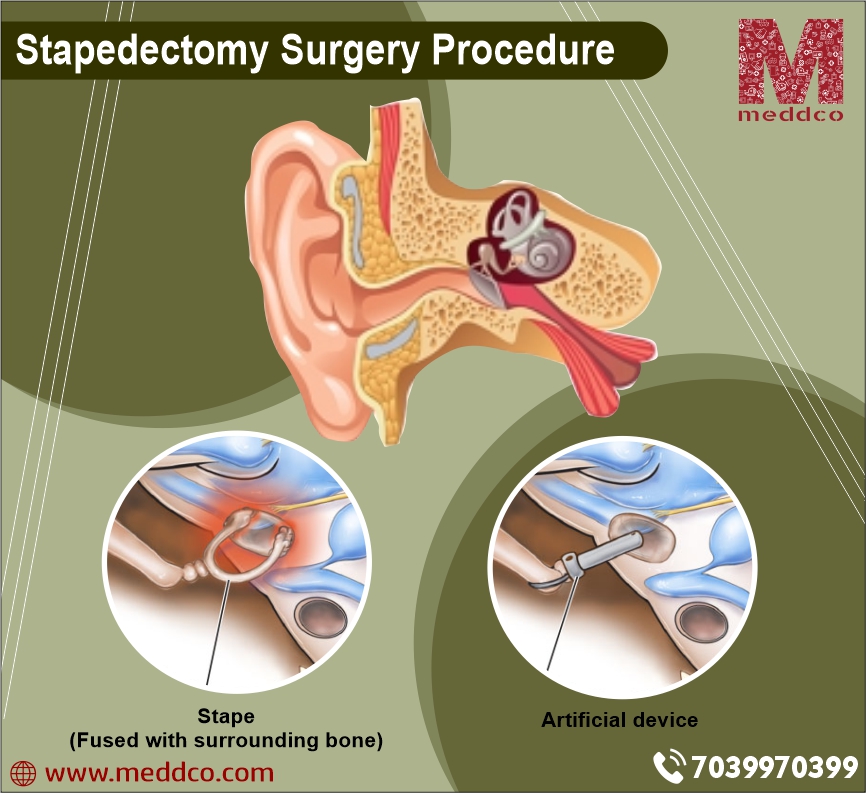

: Admin : 2022-07-01
One of the best surgeries, a Stapedectomy, is done to treat Otosclerosis-related hearing loss. The stape, a little U-shaped bone in the middle ear, is harmed by this disorder, which impairs your hearing. By transmitting sound waves from your middle ear to your inner ear, your stape aids in hearing. Medical professionals use an artificial device to replace your broken stape during a stapedectomy.
What is meant by stapedectomy surgery?
An ear surgery called a stapedectomy addresses hearing loss brought on by otosclerosis. Conduction hearing loss is caused by the condition'sldup, which prevents the stapes (stirrup bone) from moving correctly.
More than 90% of the time, stapedectomy successfully restores hearing, and the improvement in hearing is frequently permanent. There are a few instances where the hearing does not improve. Only 2% of people will experience severe hearing loss to render a hearing aid ineffective. Other hazards include taste changes, which generally resolve entirely, and dizziness, which seldom lasts longer than a week.
Symptoms of otosclerosis
Over time, you can become aware that you have problems hearing people when they whisper if you have otosclerosis. Low-pitched sounds may be difficult for you to hear.
When there is a lot of background noise, you might be able to hear better. Otosclerosis patients might begin speaking more softly because they feel their voice is overly loud.
When is stapedectomy needed?
The abnormal growth of additional bone surrounding the stapes is known as otosclerosis. Hearing loss occurs due to the stapes' istapes'y vibrating due to the growth. Otosclerosis is a slow-growing condition that typically affects both ears. It is hereditary in some families.
The third and nearest to the inner ear of the middle ear's threar'sall bones are called the stapes. It is sometimes referred to as the stirrup due to its form.
What is the procedure of stapedectomy surgery?
Using an operating microscope, the surgeon does the surgery through the ear canal. To reveal the middle ear bones, the eardrum is raised. The eardrum is positioned to heal after the stapes are removed, and it is maintained in place by packing material that the body will eventually absorb.
Most patients can go home the same day after the treatment, which lasts about 90 minutes. The patient is made more relaxed but not entirely unconscious by the local anaesthetic used by the surgeon. Numbing medication is administered in the ear where the actual operation is performed. With this method, the surgeon can examine the patients after the procedure.
Results of stapedectomy surgery
Typically, the procedure is a complete success for 90 out of every 100 patients, leaving them with enhanced hearing. The hearing will be restored to almost normal levels if inner ear processes are normal.
Patients report better hearing during and immediately after surgery but also note that things could not sound normal. Once the packing surrounding the eardrum has been absorbed, and fluid has drained from the ear, the feeling of fullness usually disappears. Over the following three to four months, hearing continues typically to improve.
Other beneficial outcomes of the surgery:
The aftermath of stapedectomy surgery :
Overview
Compared to hearing aids, stapedectomy seems to be a more affordable choice for treating otosclerosis from the patient's view.
Stapedectomy is a cost-effective strategy for treating otosclerosis from the patient's perspective since it maximizes the quality of life while minimizing patient expense, according to the cost-effectiveness of the treatments for otosclerosis. As a result of lowering payer costs and providing benefits to the patient, we also demonstrated that hearing aids are cost-effective from a Medicare standpoint.
MEDDCO.COM is India's first digital pricing online platform, where price transparency is the key.
Our website allows users to search for surgical procedure diagnostic tests and other healthcare services amongst various hospitals and
a healthcare provider in and around the location of the user to compare the cost of services, compare the quality of services by the user
rating/reviews to make an informed decision.
On our website, you can find the best package price for Stapedectomy. You can also book an online appointment through our website.
For more information visit our website.
No Comments